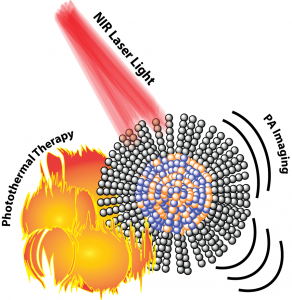There remains a large number of unknowns surrounding how nanomedicines interact with the heterogeneous tumour microenvironment and how certain particles permeate through the tumour mass. Here we aim to gain insight into the nanoparticle-tumour interaction by means of photoacoustic (PA) molecular imaging utilizing multispectral optoacoustic tomography (MSOT). This involves the synthesis of a custom-designed, near-IR quenching dye with vinyl functionality to allow free radical polymerisation controlled by reversible addition fragmentation chain transfer (RAFT); for the development of polymeric PA imaging agents. This project also aims to further understand the fundamental PA contrast enhancement mechanism, to shed light on the chemical and physicochemical properties required for an optimal polymeric PA contrast agent. Through specific irradiation of the highly efficient light absorbing material, the proposed nanoparticle also provides the opportunity to act as an organic photothermal (PT) agent for tumour therapy. Thus, new theranostics are proposed that may allow quasi-simultaneous imaging and therapy whilst providing detailed information on the nanoparticle-tumour interaction and permeability within tissue.

